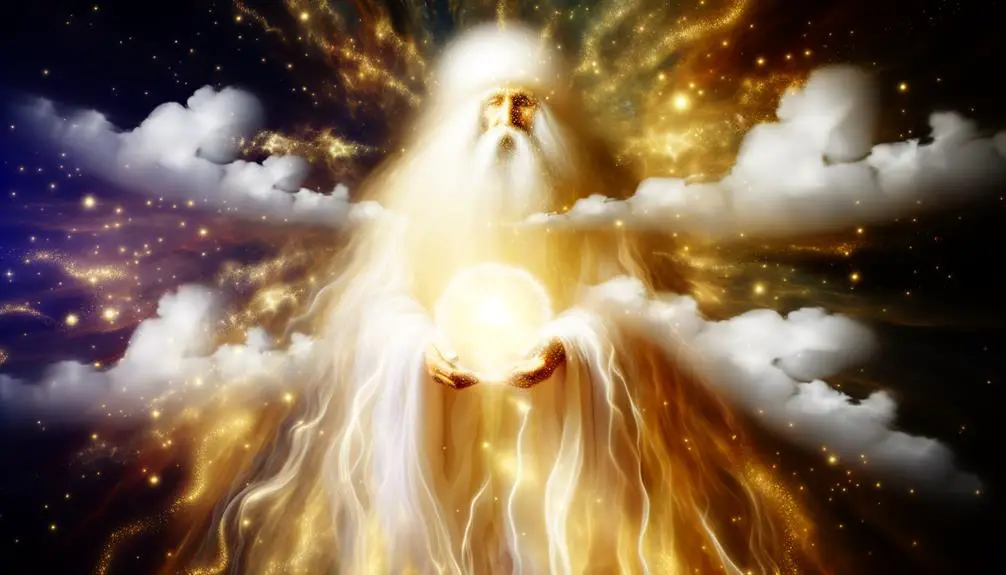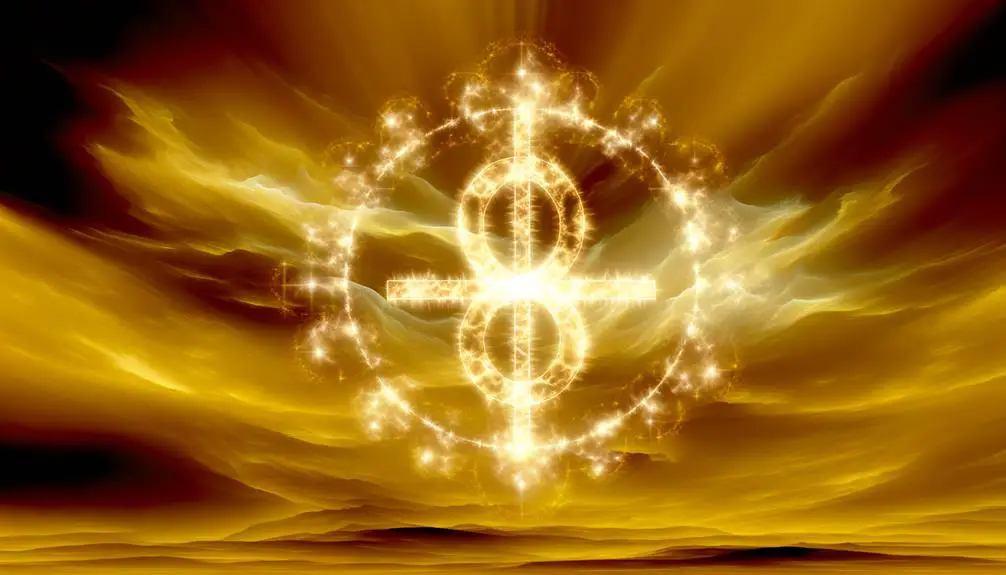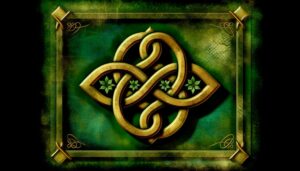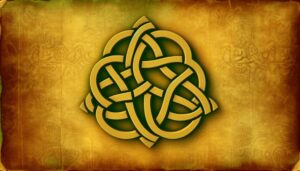Symbol for God the Father in Christianity?
The symbols representing God the Father are deeply rooted in Christian theology and iconography. Notable among these are the Hand of God, denoting divine authority and intervention, and the Throne of Majesty, symbolizing sovereign rule.
The All-Seeing Eye highlights divine omniscience, while the Shepherd's Staff signifies guidance and care. The Protective Shield and the Eternal Light illustrate God's guardianship and the divine presence respectively.
Scripturally, God is also represented as the Alpha and Omega, emphasizing eternal existence and omnipotence. Exploring these symbols uncovers rich layers of understanding regarding the multifaceted nature of the divine.

Key Takeaways
- The Hand of God symbolizes God's authority, intervention, and omnipotence.
- The Throne of Majesty represents divine sovereignty, supreme authority, and kingship.
- The Alpha and Omega symbol signifies God's eternal nature, from beginning to end.
- The All-Seeing Eye depicts divine omniscience, omnipresence, and watchfulness.
- The Protective Shield epitomizes divine safeguarding, defense, and assurance of God's guardianship.
The Hand of God

The Hand of God, often depicted in religious iconography, serves as a profound symbol of divine intervention and authority. This imagery, rooted in ancient Judaic and Christian traditions, encapsulates the omnipotence and omnipresence of God the Father.
In art, the hand emerges from the heavens, emphasizing the act of creation, guidance, and protection. Theologically, it signifies God's active participation in the world, manifesting His will and benevolence. This symbol transcends mere artistic representation, embodying the essence of divine providence and justice.
Scholars have noted its recurring presence in various religious texts and artifacts, highlighting its enduring relevance. Hence, the Hand of God remains a potent emblem, bridging the human and the divine through its profound symbology.
The Throne of Majesty
Frequently depicted in religious art and scripture, the Throne of Majesty symbolizes the supreme authority and sovereignty of God the Father. This potent emblem serves as a visual representation of divine kingship and celestial governance. It conveys a multitude of theological concepts through its intricate and often awe-inspiring iconography.
The Throne of Majesty is traditionally illustrated with elements that evoke reverence and majesty:
- A celestial throne embellished with precious stones.
- Radiant light emanating from the throne, signifying divine illumination.
- Angelic beings in attendance, underscoring divine authority.
- A rainbow encircling the throne, symbolizing God's covenant.
- Scrolls or books representing divine decrees and wisdom.
These elements collectively reinforce the transcendence and omnipotence of God the Father.
The All-Seeing Eye

The All-Seeing Eye, historically rooted in ancient iconography, has been adopted across various religious traditions as a potent symbol of divine omniscience.
Its enduring presence in contemporary religious contexts underscores its profound spiritual significance, reflecting an ever-watchful and omnipresent God.
The interpretations of this symbol vary widely, offering rich insight into its multifaceted role in theological discourse.
Historical Origins Explained
In tracing the historical origins of the All-Seeing Eye as a symbol for God the Father, it is essential to understand its deep roots in ancient religious traditions and iconography. This emblem transcends cultures, manifesting in various forms that underscore its universality.
- Ancient Egypt: Depicted as the Eye of Horus, it symbolized protection and divine oversight.
- Hinduism: Represented by the third eye of Shiva, indicating omniscience.
- Christianity: Enclosed within a triangle, it signifies the Holy Trinity and divine omnipresence.
- Freemasonry: A symbol of the Great Architect of the Universe, embodying watchfulness.
- Renaissance Art: Frequently used to denote God's omnipotence and vigilance.
These historical contexts provide a rich tapestry, illustrating the enduring relevance of the All-Seeing Eye as a profound symbol.
Religious Significance Today
Today, the All-Seeing Eye continues to hold profound religious significance, serving as a potent symbol of divine surveillance and spiritual insight across diverse faith traditions.
In Christianity, it is often associated with the omniscience of God the Father, suggesting His perpetual vigilance over creation.
Within Freemasonry, the symbol represents the watchful eye of a Supreme Being, emphasizing moral and ethical rectitude.
This emblem also appears in various Eastern philosophies, where it signifies enlightenment and the transcendence of ordinary perception.
The All-Seeing Eye's enduring relevance underscores its capacity to convey universal themes of divine presence and spiritual awareness, resonating deeply with contemporary believers who seek a tangible representation of an omnipotent, omnipresent deity.
Symbolic Interpretations Varied
Diverse cultural and religious contexts have imbued the All-Seeing Eye with a multitude of symbolic interpretations, reflecting its adaptable and profound significance. This emblem, often depicted as an eye encased within a triangle and radiating light, serves various purposes across traditions:
- Divine Providence: Representing God's omnipresence and omniscience.
- Spiritual Insight: Symbolizing enlightenment and inner vision.
- Protection: Acting as a guardian against evil forces.
- Moral Integrity: Emphasizing ethical vigilance and righteousness.
- Unity: Denoting the interconnectedness of all beings under divine observation.
These interpretations underscore the All-Seeing Eye's role as a potent symbol in conveying the transcendent and ever-watchful nature of the divine, particularly in the context of God the Father.
The Shepherd's Staff
A profound symbol of God the Father, the shepherd's staff represents guidance, protection, and authority within the Christian tradition. This emblem is deeply rooted in biblical imagery, often associated with pastoral care and divine leadership. The shepherd's staff serves as a metaphor for God's unwavering vigilance over His flock, ensuring their safety and direction.
| Symbolic Aspect | Representation | Biblical Reference |
|---|---|---|
| Guidance | Leading the flock to safe pastures | Psalm 23:1-4 |
| Protection | Defending against threats | John 10:11-15 |
| Authority | Exercising control and oversight | Ezekiel 34:23-24 |
Analyzing the shepherd's staff elucidates its role as a multifaceted symbol of divine providence, illustrating the Father's enduring commitment to His people.
The Protective Shield

The protective shield, as a symbol of God the Father, epitomizes divine safeguarding and the omnipotent defense bestowed upon believers. This emblem not only signifies physical protection but also embodies spiritual fortitude and unwavering faith.
The shield's representation can be unpacked through various aspects:
- Sanctuary from adversity: it provides refuge during life's trials.
- Symbol of strength: it reflects the omnipotence of the divine.
- Barrier against malevolence: it guards against spiritual harm.
- Assurance of divine presence: it signifies God's omnipresence.
- Encouragement of unwavering faith: it bolsters the believer's trust in divine protection.
This sacred symbol reassures the faithful of God the Father's enduring guardianship, offering a profound sense of security and peace.
The Eternal Light
The Eternal Light serves as a profound symbol for God the Father, encompassing both divine radiance and the illuminating presence found throughout scriptural references.
This motif not only signifies the unending and omnipresent nature of God's essence but also underscores His role as the ultimate source of wisdom and guidance.
Divine Radiance Symbolism
How does the symbolism of divine radiance, often referred to as the Eternal Light, encapsulate the omnipotence and omnipresence of God the Father?
This profound imagery evokes an understanding that transcends mere visual representation and taps into the essence of divine attributes.
The Eternal Light signifies God's boundless power and pervasive presence, illuminating the cosmos and the human soul alike.
Consider the following imagery:
- A beacon of hope in darkness: Symbolizing guidance and protection.
- An all-encompassing glow: Emphasizing God's ubiquitous nature.
- A radiant source of warmth: Denoting divine love and comfort.
- An unending flame: Representing eternal life and constancy.
- A celestial light: Reflecting purity and sanctity.
These symbols collectively articulate the multifaceted dimensions of God's eternal and omnipotent nature.
Light in Scripture
Scriptural references to radiance profoundly underscore its significance as a symbol of God's eternal presence and divine truth. In the Old Writings, radiance is often associated with God's guidance and revelation, as seen in Psalm 119:105: 'Your word is a lamp for my feet, a gleam on my path.'
The New Writings further elucidate this symbolism, with Jesus proclaiming, 'I am the radiance of the world' (John 8:12), signifying His divine nature and mission to illuminate humanity.
Revelation 21:23 epitomizes the culmination of this imagery: 'The city does not need the sun or the moon to shine on it, for the glory of God gives it radiance.' Thus, radiance in Scripture encapsulates the eternal and omnipresent essence of God the Father.
The Alpha and Omega

Revered as a profound symbol of God's eternal nature, 'Alpha and Omega' denotes the encompassing presence and omnipotence of God the Father. Originating from the Greek alphabet, where Alpha signifies the beginning and Omega the end, this symbol encapsulates the concept of God's timeless existence and ultimate authority. It assures believers of God's unchanging essence and sovereign control over all creation.
- Alpha and Omega: representing the entirety of existence from beginning to end.
- Divine Omnipotence: emphasizing God's all-powerful nature.
- Eternal Presence: illustrating God's perpetual existence.
- Scriptural Basis: found in Revelation 1:8, 21:6, and 22:13.
- Theological Significance: underscoring God's role as the origin and culmination of all things.
This profound symbol invites reflection on the infinite and immutable nature of God.
Conclusion
To sum up, the myriad symbols representing God the Father—each as profound as the cosmos itself—offer a rich tapestry through which the divine nature is both revered and understood.
From the Hand of God and the Throne of Majesty to the Alpha and Omega, these emblems encapsulate the omnipotence, omniscience, and eternal presence of the divine.
Such symbols serve as both theological anchors and artistic expressions, fostering a deeper connection to the ineffable and the sacred.





